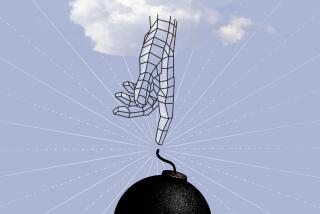Of Gadgets and Gizmos
- Share via
In the geology of the material world, we nest in layers within layers within layers. At the core, there are the basics, surrounded by a densely packed shell of necessities, enveloped in turn by sedimentary beds of stuff and petrified conglomerates of clutter, overlaid with pyroclastic mounds of possessions. Indeed, we inhabit a world of cryptic manufactured objects. For most of us, each one poses the same nagging question: How does this damn thing work?
While philosophers and physicists may possess the mental acuity to contemplate the cosmic questions of string theory and quantum mechanics, far more of us would be content if only we could fathom the mysteries of a toilet ball cock, a kitchen smoke detector, power brakes or--Lord help us--a computer microprocessor.
Coming to the aid of those of us who are forever baffled by things mechanical, electrical or hydraulic, David Macaulay, writer, illustrator, tinkerer nonpareil, created what has become a household bible on the way things work. Issued first in 1988 and then as a CD-ROM in 1995, Macaulay’s “The Way Things Work” sold 2.5 million copies worldwide.
Now it has been refurbished, expanded and reissued. “The New Way Things Work” has substantial new material that lays bare the working of digital things, from solar cells and optical character recognition to supermarket scanners, random-access memory and airline reservation systems.
Each object is rendered by Macaulay’s painter’s brush in precise but never pedantic detail with a wash of muted watercolors. The text is lucidly set down by science writer Neil Ardley without losing the general reader in too much jargon. With wit and considerable verve, Macaulay and Ardley attempt to make simple the intricate workings of the silicon chip, the videotape recorder and the many trails that e-mail can take, to name a few.
When the explanations start to sink under the weight of efforts to elucidate the fluid effects of density or the read-write heads of a computer disk drive, Macaulay depicts the narrative antics of a bemused woolly mammoth--a visual tribute no doubt to the reader’s own woolly thinking--as a droll foil. Its wide-eyed ignorance frames the explanations throughout the volume. On different pages, this prehistoric tourist of technology taps out a tune with its trunk on an electric keyboard, dons a leather pilot’s helmet to board a Navy jump-jet or becomes part of the active computer code in a software program.
Some additions to the new edition, like the terse description of a hand-held translator that tourists might use to read a foreign text, are disappointingly didactic. They are written in the grudgingly unhelpful spirit of the dictionary that defines the Second World War as World War II.
Others, like the breakdown of the workings of an ink-jet printer, a scanner and a liquid-crystal computer screen, are marvels of succinct explanation. They more than live up to the gold standard set by the original book’s chapters.
It may be that the difficulty with computerized things reflects the authors’ underlying uneasiness about the slippery intangibility of all those electronic ones and zeros at the heart of so many digital devices.
As Macaulay notes in an epilogue: “While the mammoth had been impressed by much of the digital domain, there also was plenty about it that left him feeling uncomfortable. In the end, it was just too much, too big, too fast and too unfamiliar. Mammoths, after all, had never really embraced the concept of progress and this one wasn’t going to start now. In fact, as he left the digital domain, he had no intention of ever returning.”
In any case, this whimsical and well-intentioned book is too rich to be read in one sitting; rather it is a thing itself to be savored a page or two at a time, consulted when a child’s question begs to be answered, when the daily conspiracy of inanimate objects becomes too much to be borne or whenever an idle hour beckons.
More to Read
Sign up for our Book Club newsletter
Get the latest news, events and more from the Los Angeles Times Book Club, and help us get L.A. reading and talking.
You may occasionally receive promotional content from the Los Angeles Times.










